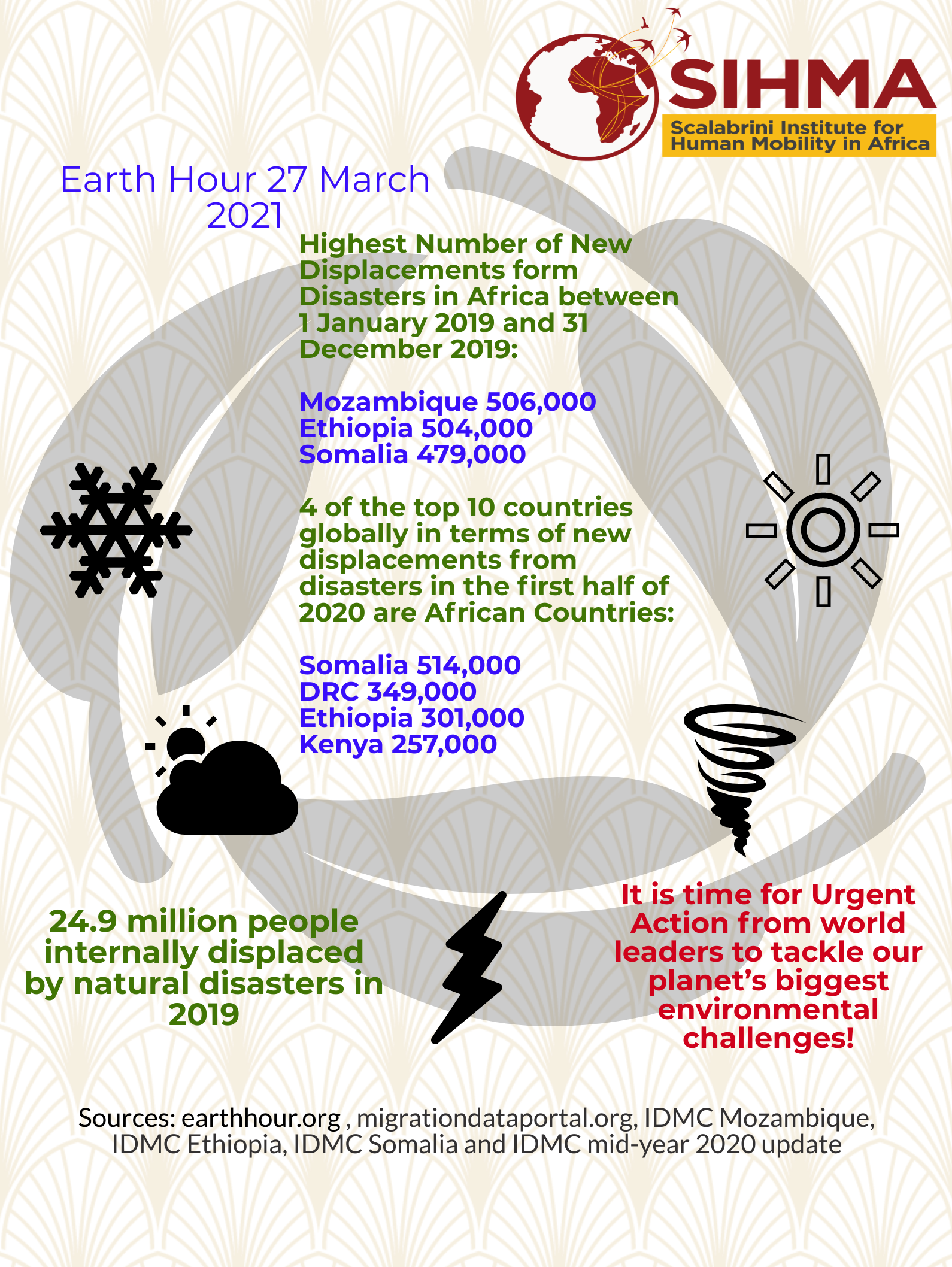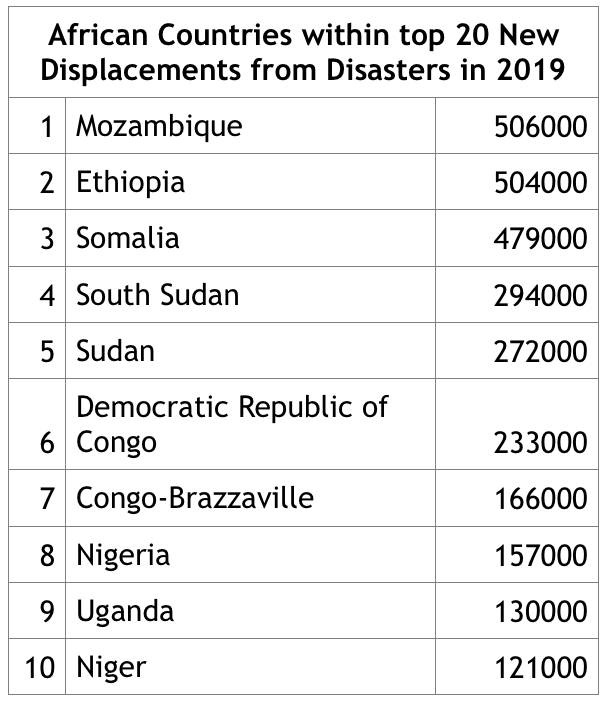
Climate and Migration
We often hear about forced migration and the plight of refugees or about labour migration and indeed about Climate Change. Yet we do not hear as readily about the impact of climate change and natural disasters on migration. It is important to reflect on this and to consider important steps that should be taken to protect and care for our planet and for the African Continent and her inhabitants. It is also crucial to advocate for world leaders to take decisive and concrete steps to preserve and care for the planet. This is particularly topical as earth hour was observed on 27 March 2021 and with climate and nature summits to follow later this year.
We should consider the impact of natural disasters on migration. Not only do hundreds of thousands of people cross borders as they are forced to flee from disasters, but millions are also internally displaced with in countries as a consequence of climate related disasters. At the end of 2019 there were 50.8 million Internally displaced persons globally [1] with 24.9 million people internally displaced by natural disasters [2]. Mozambique, Malawi and Zimbabwe experienced large scale displacement from Cyclone Idai which started on 4 March 2019 with 478,000 people displaced in Mozambique, 110,000 in Malawi and about 51,000 in Zimbabwe, while in Somalia Gu Rains flooded 15 regions displacing 407,000 people in October 2019 [3]. In Sudan and in South Sudan approximately 270,000 and 250,000 people were displaced due to rain and flooding in May and July 2019 respectively with 16 Sudan states effected in the May 2019 disaster and 7 South Sudan states effected by the July disaster [3]. Flooding in separate events in May and September 2019 displaced 190,000 and 177,000 people respectively in Ethiopia [3].
Mozambique, Ethiopia, and Somalia each had approximately 500,000 New displacements from disasters between 1 January 2019 and 31 December 2019. In fact of the 20 countries with the highest number of new displacements due to disasters in 2019, 10 were African countries [3]. The countries and number of displacements are reflected in the table below:

[3]
As with other countries in East Africa, Somalia’s 479,000 new displacements from disasters, arose as Somalia was affected by extensive flooding in the second half of 2019 during an El Niño influenced unusually wet rainy season. Then in the first half of 2020, Somalia experienced a further 514,000 as a result of disasters in addition to displacement from conflict and violence causing 189,000 new displacements in the same period) [4].
In the first half of 2020 of the top 10 countries in terms of new displacements globally four were from Africa namely Somalia 514,000, the Democratic Republic of Congo 349,000, Ethiopia 301,000 and Kenya 257,000 [5]. One may consider more closely the events that gave rise to these figures in the DRC and Ethiopia. In the DRC: ‘Heavy downpours, floods and landslides during the rainy season triggered most of the disaster displacement recorded, as in previous years. One of the biggest events was in the town of Uvira on the northern shores of Lake Tanganyika, where around 5,500 homes were destroyed when several rivers and the lake burst their banks... The flooding triggered around 84,000 new internal displacements, most people fleeing within the town to neighbourhoods spared from its effects.’[5] In terms of disaster displacement in Ethiopia: ‘Heavy flooding and landslides affected the Somali, Oromia, Afar, Dire Dawa and Southern Nations, Nationalities and People’s (SNNP) regions in first half of 2020. Somali accounted for around two-thirds of the disaster displacements recorded nationwide.’[5]
The most internal displacement globally is triggered by storms and floods and historical seasonal data in relation to these hazards provides an idea of displacement one might expect across different regions and countries in the future [5]. Not only does it provide useful information to assist in understanding when and where there is a likelihood of displacement occurring, but it also allows disaster management agencies to plan and prepare and assists organisations and governments to improve measures to support recovery and to in some cases prevent displacement and to hasten the attainment of durable solutions [5].
On Saturday 27 March 2021 across the world Earth Hour was observed. In previous years Earth hour has included large communities gathering for an hour and switching off the lights /power as part of global symbolic gesture to confirm commitments and undertakings to care for the planet. In the context of the pandemic Earth Hour in 2021 did not involve gathering in large groups but rather the observance of the Earth Hour Virtual Spotlight video narrated by John Kani [6]. One of the crucial messages in the earth hour campaign is that it is time for urgent action from world leaders to tackle our planet’s biggest environmental challenges. On the 27th of March while respecting physical distance, people across the globe united ‘digitally to speak up for nature louder than ever’[6]. Earth Hour sent a clear and powerful message to the leaders of the world that millions of people globally ‘demand urgent action’ to address environmental challenges facing our planet [6]. Through earth hour people from 192 countries and territories showed their care for the future of the Planet with 2.4 million views for the virtual spotlight video in 24 hours [6]. UN Secretary-General Antonio Guterres, Pope Francis [7] and European Commission President Ursula von der Leyen and many other world leaders and celebrities virtually gathered in support of Earth Hour 2021, to bring the focus on the nature and climate crises [8].
In conclusion it is crucial that dedicated and deliberate measures are put in place to address the environmental challenges facing us at all levels and SIHMA supports and promotes processes towards this goal particularly cognisant of the impact on people on the move and especially people on the move within and from Africa.
James Chapman
SIHMA
Project Manager
INTEREST IN WRITING SOMETHING FOR SIHMA?
If you are interested in contributing to the SIHMA Blog on the Move please contact us at: https://www.sihma.org.za/contact or if you are interested writing an article to be reviewed and published in the African Human Mobility Review, please follow this link on making a submission: https://www.sihma.org.za/submit-an-article
Sources
- IDMC - https://www.internal-displacement.org/
- IOM Data Portal - https://migrationdataportal.org/?i=idp_flow_disaster&t=2019&m=1&rm49=2
- IDMC Displacement Data - https://www.internal-displacement.org/database/displacement-data
- IDMC Somalia - https://www.internal-displacement.org/countries/somalia
- IDMC mid-year 2020 update - https://www.internal-displacement.org/sites/default/files/publications/documents/2020%20Mid-year%20update.pdf#page=11
- Earth Hour 2021 - https://www.earthhour.org/
- Pope Francis has consistently addressed issues relating to migration and challenges faced by people on the move and in His messages, regularly addresses how climate change and natural disasters are major drivers of displacement and increased vulnerability. Yet, in the words of Pope Francis, ‘Sadly, the urgency of this ecological conversion seems not to have been grasped by international politics, where the response to the problems raised by global issues such as climate change remains very weak and a source of grave concern. The XXV Conference of the Parties to the United Nations Framework Convention on Climate Change (COP25), held in Madrid last December, raises serious concern about the will of the international community to confront with wisdom and effectiveness the phenomenon of global warming, which demands a collective response capable of placing the common good over particular interests. - https://www.vatican.va/content/francesco/en/speeches/2020/january/documents/papa-francesco_20200109_corpo-diplomatico.html
Also see: https://jrs.net/en/news/message-of-pope-francis-for-world-day-of-migrants-and-refugees-2020/ and https://catholicclimatecovenant.org/resource/pope-francis-prayer-our-earth
- Panda – World Wildlife Fund for Nature - https://wwf.panda.org/wwf_news/?1871966/Earth-Hour-2021-breaks-all-records-calling- sfor-action-in-crucial-year-for-climate-people-and-nature
Ethi
https://www.internal-displacement.org/countries/mozambique 506000 mozambique New displacements from disasters between 1 January 2019 and 31 December 2019
https://www.internal-displacement.org/countries/ethiopia 504000 Ethiopia New displacements from disasters
https://www.internal-displacement.org/countries/somalia 479 000 Somalia New displacements from disasters between 1 January 2019 and 31 December 2019
In the first half of 2020 of the top 10 countries in terms of new displacements from disasters four were from Africa namely the Somalia 514,000, Democratic Republic of Congo 349,000, Ethiopia 301,000 and Kenya 257,000. https://www.internal-displacement.org/sites/default/files/publications/documents/2020%20Mid-year%20update.pdf#page=11
https://www.internal-displacement.org/countries/mozambique 506000 mozambique New displacements from disasters between 1 January 2019 and 31 December 2019
https://www.internal-displacement.org/countries/ethiopia 504000 Ethiopia New displacements from disasters
https://www.internal-displacement.org/countries/somalia 479 000 Somalia New displacements from disasters between 1 January 2019 and 31 December 2019
Disasters triggered 479,000 new displacements. In common with other countries in East Africa, Somalia was affected by widespread flooding in the second half of 2019 during an unusually wet rainy season influenced by El Niño.
In the first half of 2020, there were 189,000 new displacements associated with conflict and violence and 514,000 as a result of disasters. https://www.internal-displacement.org/countries/somalia
Categories:
Tags:

